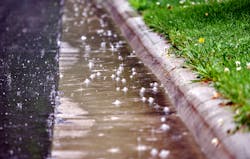Green infrastructure-based approaches to urban drainage have been a growing topic of consideration in recent years. Sustainable Urban Drainage Systems (SUDS) have made significant strides over the last decade; once the wave of the future, they are becoming more common approaches to stormwater management.
This article will explore why SUDS were first introduced in the first place, what they are trying to manage, how they are used, and why they are so important.
What are Sustainable Drainage Systems?
Sustainable Drainage Systems refers to a number of sustainable approaches to managing surface water or, more precisely, drainage, flooding, and the risks of water pollution by mimicking the natural hydrological cycle.
They are designed with the purpose of re-establishing this natural cycle as much as possible. This includes the transport of surface water, slowing down its runoff, and providing areas that can allow the natural infiltration of water into the ground or other storage.
The ultimate goal of Sustainable Drainage Systems is the protection of both nature and human health while supporting sustainable development.
As a natural resource, water is renewed through a water cycle (evapotranspiration) in which water vapor is transferred from the surface of the Earth (from sources such as oceans, lakes, rivers, land, and plants) to the atmosphere.
From there, water returns to the Earth’s surface in the form of precipitation. As runoff, water ultimately reaches the ocean through various bodies of water, but it can also infiltrate the soil, appearing as springs or as underground aquifers.
This is a continuous hydrologic cycle, and for it to continue running its natural course, there shouldn’t be any changes to the water volume in any of the phases of the process.
Unfortunately, many human activities can disrupt this hydrological cycle, and the one that has the biggest impact is urbanization. Urbanization is a complicated process, with both negative and positive impacts. Increased density can reduce the amount of land developed, but also results in a more intensely developed environment and increased use of natural resources. Urban areas often also struggle with decreased biodiversity and urban heat islands. The two biggest urban challenges that Sustainable Drainage Systems aim to address, however, are flooding and pollution.
Flooding
In urban environments, flooding is often triggered by an increase in impermeable surfaces as a result of paving, soil compaction from vehicle movement, and the construction of buildings, all of which disrupt rainwater infiltration. When water can no longer infiltrate into the soil, runoff volumes increase, which can lead to combined sewer overflow and the flooding and overflow of streams, rivers, etc.
The continuous increase of local flooding in many areas of the world has dramatic effects on people’s health, quality of life, and livelihood. Huge social and economic losses of more than $40 billion worldwide each year should not be disregarded, nor should the continuous increase of death tolls due to flooding, now amounting to more than 100 a year.
Pollution
Next to flooding, another aspect that greatly affects people’s health is pollution, another by-product of urbanization. The World Health Organization estimates that every year 3,575,000 people die from diseases caused by contaminated water and if the atmosphere is heavily polluted, rainwater can become contaminated even before reaching urban surfaces. Once it does, oil and grease residues, fecal matters, and other pollutants picked up in runoff can contribute to its contamination.
Traditional vs. Sustainable Drainage Methods
The traditional method of resolving flooding issues is focused on managing only the risk with little consideration for quality, amenities, and biodiversity, often causing damage to the environment.
It consists of implementing a rainwater drainage system that drains surface water directly and quickly into the underground, which is known as pipe drainage. Linear surface drainage includes infrastructure such as catch basins, manholes, and trench drain systems that are used to collect rainwater.
However, this approach isn’t enough on its own; with the continuous increase of urbanization and city growth, the area of impermeable surface increases as well, and new flooding spots appear. It is becoming more evident that the natural hydrological process has been altered to such an extent that these traditional solutions alone are often ineffective.
This is why a new model of water treatment has been introduced, in which water is regarded as a valuable resource and its processes and natural flow mechanisms replicated as closely as possible.
The principle of Sustainable Drainage Systems is to capture and use rainwater as opposed to the traditional viewpoint of water as a nuisance.
Philosophy of Sustainable Drainage Systems
Sustainable Drainage Systems are designed in accordance with the opportunities and constraints of each individual site and with the goal to mimic its natural drainage processes. The principle is to manage surface water runoff for the maximum benefit of:
- Water quantity: maintaining and protecting the natural water cycle to mitigate flood risks
- Water quality: preventing pollution
- Biodiversity: leaving nature undisturbed and sustaining its growth
- Amenity: creating safe and healthy human environments
This is a concept that takes into consideration long term environmental and societal factors into decision making and prioritizes a variety of benefits to both humans and the environment.
Techniques
As a high-quality drainage system, the term “Sustainable Urban Drainage System” encompasses various techniques and strategies that can mitigate the consequences of urbanization that affects the drainage of surface water.
- Permeable and semipermeable pavement: for diverting surface runoff into a rock reservoir located beneath retention/detention reservoirs
- Wetlands (swamps, marshes, lowlands, etc.): natural or constructed, they minimize the risk of residual waters with high levels of filtering
- Infiltration trench: intended as storage for larger volumes of water which will gradually infiltrate the soil
- Infiltration ditch and gulley: designed for collecting water as temporary storage, reducing peak flows, favoring infiltration, and aiding in filtering
- Micro reservoirs: intended as storage for precipitated water, mitigating peak flow
- Infiltration well: allow runoff infiltration
- Rooftop reservoirs: act as rainwater storage which gradually releases it to the rainwater network
- Green roofing: collects rainwater that can the be used as a substitute for treated water, reduces local peak rainwater flows, improves water quality, carries benefits for fauna, and can act as thermal and acoustic insulations and mitigate heat in buildings
Benefits
Choosing any Sustainable Drainage Systems technique over traditional ones include many positive benefits, such as:
- reducing flooding;
- alleviating the pressure from existing drainage systems;
- prevention of water contamination and amelioration of its quality;
- creating habitats for the local biotope;
- creating amenities, recreational, and educational opportunities for people, thus improving their quality of life;
- contributing to the sustainability of urban spaces, making them more resilient to change; and
- improving air quality, regulating temperature, and reducing noise in urban areas.
Today, more than ever, it is evident that human activities have affected the environmental processes to such an extent that nature is no longer able to cope with the consequences alone.
As by-products of one of the most common and increasing human activities—urbanization and the disruption of the natural hydrological cycle—floods and pollution can no longer be mitigated by traditional drainage systems. Without taking into account long term environmental and societal consequences, they end up causing more damage.
Sustainable Drainage Systems are increasingly adopted and implemented by many local authorities and developers as the most efficient solution to flooding and water pollution problems. Environmentally favorable, causing little to no long term damage, SUDS are designed to drain surface water effectively and sustainably while providing numerous benefits for the whole ecosystem.
About the Author
Ankit Sehgal
Ankit Sehgal is the president and head of engineering at Swiftdrain Inc., a global drainage and infrastructure products manufacturing company. He oversees all product design and development at the firm, including engineering, materials sourcing, and production. He has a passion for infrastructure planning and drainage design.


